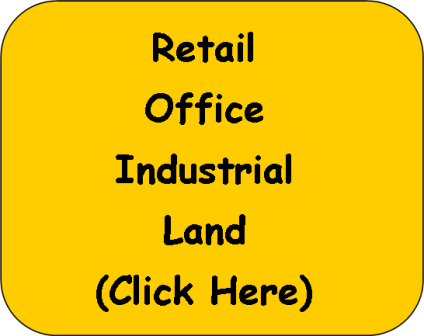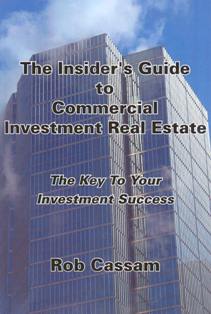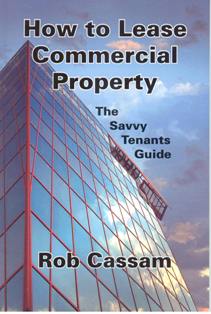For those of you keeping
track, please note I have changed my email address to
robcassam@gmail.com.
Please update your records.
In this issue I focus on a variety
of important commercial real estate topics for both tenants and owners. I hope some of these may
help you know or in the future. This new format includes money making tips
for all types of commercial real estate including tips for end users of
commercial real estate.
|
|
2012 Year-End Review From CCIM Institute
|
|
Throughout the past
year, CCIM Institute
had three top
priorities: increase
liquidity, prevent
burdensome
regulations, and
create awareness of
how federal tax
policies impact
commercial real
estate.Read
more. |
|
Federal Tax Policy
with Fiscal Cliff
Updates |
Federal tax code has
not substantially
changed for over two
decades. 2013 brings
a new set of rules
and guidelines for
all U.S. tax payers.
Keep in mind that
filing for 2013, is
not due until April
2014. Individuals,
families and
businesses across
the board (not only
higher-income
individuals or
households) will be
to some degree,
impacted by federal
tax rate changes
negotiated through
the fiscal cliff
deal.
Capital
Gains/Carried
Interest
The capital
gains/carried
interest rate will
increase to 20
percent for
individuals with and
adjusted gross
income more than
$400,000 and married
couples with AGI
more than $450,000.
Individuals/couples
below the
$400,000/$450,000
AGI level will still
pay 15 percent.
3.8
Percent Healthcare
Tax
Passed under the
Affordable Care Act
in 2010, the 3.8
percent healthcare
tax will affect some
real estate
transactions.
Individuals with AGI
more than $200,000
and married couples
with AGI more than
$250,000 may be
subject to the 3.8
percent healthcare
tax.
Payroll Tax
In February last
year, the payroll
tax cut was extended
until Dec. 31, 2012.
Payroll tax includes
Social Security
payments that were
cut to 4.2 percent
instead of 6.2
percent. Without
language included in
the fiscal cliff
deal, the payroll
tax reverted back to
the pre-recession
level, 6.2 percent.
It is estimated that
the average worker
will pay about
$1,000 more in taxes
annually, or about
$42 per pay check.
Alternative Minimum
Tax
Under the fiscal
cliff deal, the AMT
received a permanent
fix and will adjust
for inflation. The
AMT will be less
burdensome on
lower-income levels
with more exemptions
for credits or tax
deductions whereas
higher-income levels
will receive less
exemption
opportunities.
Exemptions and
Deductions
Individuals with AGI
more than $250,000
and couples with AGI
more than $300,000
should expect a
phase out of the
personal exemption
of $3,800 and
itemized deduction
write-offs.
Direction on the
"Pease" provision
was included in the
fiscal deal ("Pease"
is named after
Congressman Don
Pease (OH) who
created an itemized
deduction phase out
in 1990). The
itemized deduction
phase out was
avoided with the
recession and
Bush-era tax cuts.
As clarified by the
fiscal deal, the
"Pease" provision
will now eliminate
up to 80 percent of
deductibles for
$300,000 AGI couples
or $250,000 AGI
individuals:
including charitable
donations and
mortgage interest.
Estate and Gift Tax
Estate or gift taxes
will be taxed at or
above the $5 million
(per person) level
but the tax rate
will increase from
35 percent to 40
percent in 2013.
Depreciation
("bonus")
Businesses may
deduct up to 50
percent of expenses
(property and
equipment), not
including real
estate for the 2013
tax year.
Leasehold
Improvements
There is a 15-year
straight-line cost
recovery for
qualified leasehold
improvements on
commercial
properties that
extends through 2013
and is retroactive
for 2012.
Income Tax Rates
The greatest change
will be for
individuals with AGI
over $400,000 and
married couples with
AGI over $450,000; a
new tax rate of 39.6
percent applies to
this income level.
For incomes below,
the Bush-era tax
rates became
permanent.
On January 3,
2013 the Internal
Revenue Service
released a guide
on new federal tax
rates, Updated
Withholding Guidance
for 2013. Read
more.
The fiscal cliff
negotiations did not
produce changes to
federal tax policies
on depreciation
recapture or passive
loss.
|
|
Final Fiscal Cliff
Stages |
|
CCIM Institute's
summary of the
fiscal cliff
negotiation stages
and final details
preventing the U.S.
economy from going
over the cliff can
be reviewed online. Read
more.
|
|
Regulation |
|
FASB
Lease Accounting
Proposed Rules
The Financial
Accounting Standards
Board’s lease
accounting proposal
has the potential to
reduce the U.S. GDP
by $27.5 billion
annually and cause a
loss of
approximately
190,000 U.S. jobs.
It is expected that
FASB will release
more information by
April 2013. Read
more.
Basel
III/Dodd-Frank Act
The Dodd-Frank Act
requires federal
agencies to protect
consumers. Basel III
is a proposed rule
under Dodd-Frank.
Basel III is overly
complex and has the
potential to hurt
local economies. Read
more. |
|
Healthcare/Affordable
Care Act |
Individual
Healthcare Mandate
By 2014, the
individual mandate
upheld by the U.S.
Supreme court will
go into effect. Read
more. CCIMs (and
all U.S. citizens)
will either continue
having coverage
through their
employer, purchase
insurance coverage
through a health
insurance exchange,
or pay a tax
penalty. Health
Insurance Exchanges
will be set up
through their state
or the federal
government. States
had to determine by
2012 whether they
will create their
own exchange or use
the exchange the
federal government
creates. |
|
Small Business |
SBA’s
504 Refinancing Loan
Program
The Small Business
Administration’s 504
Loan Program
provided another
refinancing
opportunity for
small business
expansion plans, the
program expired in
2012 but Congress is
considering
extending the
program. Read
more. |
|
State Tax Policy |
Internet
Sales Tax
Online retailers put
brick and mortar
storefronts out of
business because
there is an unfair
advantage when tax
season rolls around.Read
more. |
|
Basics of Land Develpment
|
The acquisition and improvement of land is a
large-scale operation and requires large amounts of capital. This has
created methods of land acquisition that gives the developer access to and
control over a large enough tract to make development economical without
requiring an initial outlay of all of the capital necessary to acquire such
a tract. From the point of view of the landowner, the disposal of a large
tract at a good price may require a formula that will encourage the
developer to commit improvement and development money for part of the tract
that will build future value into the entire tract.
This may be
accomplished by the following:
• The developer sets up a master plan
that sets forth the general scheme of development and submits it for the
approval of the owner.
• The developer and owner enter into an
agreement setting forth the acreage prices for the entire property.
•
Owner and developer agree on the number of years over which the full
development is to be completed.
• To protect the owner against
freezing of his property, the developer firmly commits to buy a
predetermined number of acres each year.
• If the developer fails to
meet this schedule, the owner is released from his commitment.
A Development Agreement
Another way of handling the
problem is for the developer to share the net profits from the land
development with the landowner. This can be done by a "land development
agreement" in which the developer agrees to perform the platting, the laying
out, the installation of lot improvements, and the promotion of the
subdivision. The landowner agrees to accept a percentage of the sales price
of each lot, with a fixed minimum guaranteed. For example, the developer
agrees to pay net to the landowner 25% of the sales price of each lot sold,
with a minimum of $50,000 per lot.
With this kind of arrangement, it
is important to protect the landowner from finding his land cluttered up
with liens left by a subdivider who went broke. The landowner should
consider confining the developer or subdivider to a small tract of land at a
time and give him "rolling options" to acquire additional parcels at
intervals over a period of time. Failure to keep up with this purchase
program results in loss of future options. The land that has been optioned
but not purchased is not subject to liens against the developer.
Benefits Of Developing On Leased Land
The bundle of
benefits for the lessee and lessor in a development on leased land are
remarkable. The separate owners, land owner and building owner, come
together in one investment at the same location. The land owner has a good
lease to the owner of the improvement. The owner of the building puts up
less money since the ownership of land is not part of the expenses in the
development.
What The Lessor Wants
An
example could be the developer of upscale homes who wants to keep the
ownership of the land as an investment. The use of the land lease can widen
his market by reducing the purchase price of the house. In certain parts of
the country, the value of the land equals the value of the house. Leasing
the land can cut the purchase price nearly in half. With this type of land
lease, there is usually a provision for a rent increase halfway through the
lease term in accordance with the results of a reappraisal of the land.
The Benefits To The Builder
The land lease
results in the following benefits for a builder or developer:
•
He/she can acquire a valuable parcel of land with very little cash
investment.
• This leasehold that is acquired is an asset that can
increase in value, and then could be used as security for a loan, or could
be sold for a profit.
• The rental payments are fully deductible by
the lessee.
• With a subordinated land lease, the lessee-developer
gets the equivalent of a 100% loan on the land.
The Best
Lease For Both
Usually, a developer-lessee will attempt to
get the longest possible term in the lease because the shorter term land
lease would have a smaller market for resale. A long-term land lease is
generally a net lease under which the lessee pays the carrying costs,
including real estate taxes.
When the land rental is a fixed amount,
it is a percentage of the fair market value of the land when the lease is
executed. This lease will often include a provision for reappraisal of the
land at fixed intervals, with new adjustments in the rent. In some cases,
for instance with a shopping center, the landowner might demand a share of
the percentage rentals over and above the fixed land rent. (Much of the
income in the shopping center will come from percentage overages from the
sub-lessees.
Subordination Of The Lease
If
the owner of the land will not subordinate the lease to a leasehold
mortgage, the developer should get a reduction in rent because the
unsubordination will cause his financing to be more expensive. Subordination
could be the most important item in the terms of the lease. Even a short
subordinated lease might be better than a longer unsubordinated lease, even
though the longer lease is more salable.
The landowner may or may not
allow his interest as owner-lessor to be subordinated to the interest of a
leasehold mortgagee. When there is a subordination to the mortgage, the
lender, in effect, gets a fee mortgage on the land rather than a leasehold
mortgage.
When the lease is unsubordinated, the landowner-lessor has
first rights over the lender in case the lessee-mortgagor should default.
With these terms, the lessee could find that he cannot get a loan, or can
get one only at a higher rate of interest. Without the subordination, the
mortgage is, in effect, a second lien since the lessor's claim on the rents
takes precedence over payments on the mortgage.
The objections of an
owner to subordination of the lease could be as follows:
• He could
lose the property if the lessee defaults on the leasehold mortgage.
•
Subordination reduces his possibility of mortgaging his fee interest in the
land, which would be a logical move for the lessor.
If the
subordination is part of the terms, the landowner would record his right to
receive any notice of default from the leasehold mortgagee and the right to
cure the default. The expense would be reimbursed to the owner by adding the
amount to the lessee's rent obligation.
|
|
Converting Apartments To Condos
|
The home price recovery is on! Condominium
sales soared in the past few years before the recession. They were
stimulated by retirees seeking no-maintenance living. The tax break on the
sale of a home allows the homeowner to trade-down to a lower priced unit
without the penalty of tax on the realized gain on the sale of the home.
The prices of condominiums have continued to increase at a higher rate
than the prices of single family homes.
The owners of apartments,
finding that rental prices are peaking after several years of increases,
find that the condominium conversion may be the best way to cash out a large
complex. Professional investors and contractors are also “in the hunt” for
apartment buildings that can be converted for profits.
Whether a
certain apartment property or complex is suitable for conversion into
condominiums depends on these factors:
• It must be in good condition
structurally so that a small capital investment can restore it to a safe and
marketable condition. These costs may come as a result of the owner’s
engineering study or the building code provisions of the political
subdivision. This money spent on structural restoration is important but
does little to enhance the salability of the units.
• The design and
layout of these units should be relatively spacious and functional. If the
condominium will be marketable quickly under normal market conditions,
buyers must see them as distinct and private apartments.
• It is best
if the complex is near shopping and business centers.
• The building
or buildings must give the appearance of being durable and refurbished like
new so that buyers of the units can picture it as their permanent residence.
• The best location would be near a neighborhood of single-family homes
that are valued at a price substantially higher than the price projected for
the completed condominium units. Single-family homes are the competition for
condominiums, so a location near higher priced properties makes the
condominiums more marketable.
Other favorable factors include:
• A location near a unique neighbor asset such as a park or a school.
• Solid construction including noise dampening insulation, good design,
and good parking.
• Existing rentals should be month-to-month or
short term leases that can be honored during the conversion.
If these
factors are present the complex might be a good property for conversion. The
owner or contractor can then begin the necessary feasibility studies as if
it was a new property being built from the ground up. |
|
Managing Residential Condominiums
|
Whether the condos are converted from apartments
or built from the ground up, the builder-developer, the project lender and
even the unit purchaser in a condominium project should all be concerned
with the proper management of the project. Without good management, a
project can quickly lose its value and begin a downturn.
The owners
in a condo project are free of the day-to-day maintenance cares that beset
homeowners. They can best enjoy that freedom when the project is operated
and managed by trained and capable people. The fact is that condominium
management requires the expertise of a sophisticated professional manager.
The manager's skills can be profitably employed during the project design
stage, while the building is being completed, and for the ongoing daily
operation of the condominium development.
The Design Stage
Skilled professional property managers contribute a good deal to the
success of the project by focusing their attention on building into the
project low maintenance requirements and durable materials and facilities.
They will be concerned with creating trouble free housing accommodations.
Their skills complement those of the builder and architect, and their
knowledge and experience can be very useful in achieving a set-up that makes
efficiency and economy.
Start-Up Functions
Among the first things a professional property manager will do upon taking
over the management of a project is to learn about the buildings and how
they work. He or she will determine the stage of completion and when the
remaining work will be completed.
Management functions should, as a
rule, be separate from construction and maintenance functions. The
construction superintendent should not double as the property manager or
vice versa. Regular maintenance service should be completely separate from
subcontractor follow-up service. In this way, construction costs won't
become interwoven with maintenance expenses, and customer services won't
become confused.
• Handling Move-In Problems: The property manager
must schedule move-ins so that everyone can get through this difficult
period with the least amount of friction and with the greatest economy. If
the property is a high rise structure, the problems are multiplied.
Most buildings can't accommodate many move-ins in one day. Physical
limitations of truck parking and loading areas, corridors and lobbies,
elevators, etc., all impose very definite limits on the number of move-ins
that can be handled at one time. In most situations, management will try to
handle move-ins on a phase-by-phase basis or even a floor-by-floor basis in
large buildings.
• Parking Problems: Parking spaces have to be
assigned before move-ins are scheduled. Generally parking spaces are
assigned on a first-come first-served basis.
If garage parking is
insufficient, the property manager might want to provide valet parking so
that the aisles can be used. The property manager might set up a parking
space priority list. As condominium units are resold, the unit owners that
have top priorities are entitled to the newly available spaces.
•
Perfecting Plan for Ongoing Operations: As the buildings near completion,
the property manager will have to negotiate building-service contracts, buy
janitor supplies, and perfect and complete pro-forma operating budget. The
manager will also help the homeowners' association devise rules and
regulations for the orderly operation of the common areas before the
condominium-unit owners move in.
In Operation
Once the buildings of a condominium development are completed, occupied,
and in operation, a full-time property manager will be responsible for
overseeing the operation of the entire development. He or she will be
involved, for example, with bookkeeping, housekeeping, planning for the
future, keeping peace among unit owners, everyday service problems, move ins
and move-outs and much more.
The Managers
The services of skilled, resident, professional property managers are a must
for condominium developments of 200 or more units, and are recommended for
developments with 35 or more units. Developments with fewer units, say 20 to
30, can also benefit from the services of professional property managers.
With 20 units or fewer, the part-time services of a professional property
manager might be available for a reasonable expenditure. |
|
|
|
In This Issue
|
|
2012 Year End Reivew From CCIM Institute |
|
The Basics of Land Development |
|
Converting Apartments To Condos |
|
Managing Residential Condos |
|
Featured Listings |
|

|
Latest Charlotte Area Market Fundamentals
REIS provides the latest overall market fundamentals for
office, industrual, and apartments. Enjoy reading a wealth of information in
order to understand the latest trends.
click here
|
|
Contact Information |
Rob Cassam, MBA, CCIM
Carolina Realty Advisors
1001 East Blvd. Ste. B
Charlotte NC 28203
Tel: (800) 587-4066 Ext. 100
Fax: (704) 442-8841
robcassam@gmail.com
Website
|
|
Services... |
|
I provide real estate brokerage services for small and medium sized businesses,
investors, and individuals who are fed up with losing money, paying too much
and/or, spending too much time not getting the right piece of property for their
particular situation. I act as the quarterback in the real estate transaction for my clients who coach
me in managing all of their different needs.
My clients love not needing to worry about making bad decisions or bad
investments and love winning negotiations.
Owners Of Commercial Space
How
are your properties helping you in your life?
Have
your investments turned out as planned?
What
types of problems have you had growing your portfolio?
How
has the economy impacted your rents and vacancy?
Are
you satisfied with your income and asset portfolio?
Is it meeting your needs?
How
much of a problem is dead equity in your property?
How
long are you prepared to go on doing nothing about situations in your business
that are not quite right?
End Users Of Commercial Space
What types of growing pains is your company facing with your location?
Are rising occupancy costs a challenge your company is facing?
Is having too much space or not enough space a challenge your company is
facing?
How much of a problem is dead equity in your property for you?
How long are you prepared to go on doing nothing about situations in
your business that are not quite right?
Give me a call, I may be able to help.


|

How To Lease Commercial Property |
|